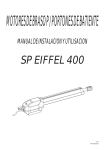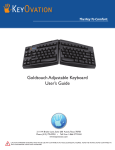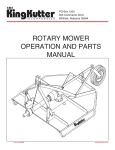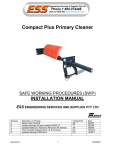Download Brutus 60010 Owner`s manual
Transcript
STK# 60010 18" Professional Tile Saw by OWNER’S MANUAL Scie à Carreaux de 460mm MANUEL D’UTILISATION Sierra Eléctrica Profesional de 460mm MANUAL DE OPERACIÓN LIMITED WARRANTY Refer to warranty card. GARANTIE LIMITÉE Faire référence à la carte de guarantie. GARANTIA LIMITADA CAUTION! Read and follow all safety and operating instructions before using this saw. ATTENTION! Lire et suivre toutes les directives de sécurité et d’opération avant d’utiliser cette scie. ¡AVISO! Lea y siga todas las instrucciones de funcionamiento y seguridad antes de usar esta sierra. Referirse a la tarjeta de guarantia. STK# 60010 18" Professional Tile Saw by Scie à Carreaux de 460mm Sierra Eléctrica Profesional de 460mm TABLE OF CONTENTS TABLE DES MATIÈRES CONTENIDO General Safety Instructions ......................................4 Electrical Requirements ............................................5 Extension Cords...........................................................6 Specific Operation Guide..........................................6 Saw Features ...............................................................6 Set Up and Operation .................................................8 Warning ........................................................................8 Stand Assembly...........................................................9 Attaching Frame to Stand..........................................9 Cutting Head Assembly............................................10 Blade Guard Assembly ............................................10 Diamond Blade Installation ...................................11 Water Tray Installation ............................................11 Water Pump Installation..........................................11 Water Pump Safety ...................................................12 Water Pump Operation & Maintenance ...............12 Cutting Depth .............................................................13 Diamond Blade Do’s & Don’ts.................................13 Cutting Operation ......................................................13 Straight Cuts with Rip Guide ..................................13 45o Angle Cuts with Angle Guide..........................14 Miter Cuts with Miter Block...................................14 Saw Maintenance.....................................................14 “Truing” the Cutting Table.......................................14 Blade Dressing ..........................................................15 Cleaning......................................................................15 Trouble Shooting .......................................................15 Parts List .....................................................................16 Exploded Parts Diagram..........................................16 Directives Générales de Sécurité .........................17 Installations Électriques..........................................18 Cordons d’Alimentation ...........................................19 Guide de Fonctionnement .......................................19 Caractéristiques de la Scie ....................................20 Réglage et Fonctionnement ....................................21 Mise en Garde ...........................................................21 Assemblage de l’Établi ............................................22 Attacher l’Armature de l’Établi...............................22 Assemblage de la Tête de Coupe ..........................23 Assemblage du Protège-Lame ...............................23 Installation de la Lame Diamantée ......................24 Installation du Plateau pour l’Eau .........................24 Installation de la Pompe à Eau ..............................24 Sécurité de la Pompe à Eau....................................25 Fonctionnement et Entretien de la Pompe à Eau............25 Profondeur de la Coupe ...........................................26 À Faire et à ne pas Faire avec la Lame Diamantée.........26 Fonctionnement de la Coupe ..................................26 Coupes Droites avec le Guide de Fente ...............26 Coupes d’Angle à 45° avec le Guide d’Angles ...........27 Coupes d’Onglets avec la Boîte à Onglets ...........27 Entretien de la Scie ..................................................27 "Dressage" de la Table de Coupe .........................27 Alignement de la Lame ............................................28 Nettoyage .................................................................. 28 Dépannage .................................................................28 Liste des Pièces ........................................................29 Diagramme des Pièces Éclaté ...............................29 Instrucciones de Seguridad General ....................30 Requisitos Eléctricos ...............................................31 Cables de Extensión.................................................32 Guía de Operación Específica................................32 Características de la Sierra....................................33 Configuración y Operación .....................................34 Advertencia................................................................34 Ensamblaje del Soporte...........................................35 Sujeción del Armazón al Soporte..........................35 Ensamblaje del Cabezal Cortador..........................36 Ensamblaje de la Protección de la Cuchilla .........36 Instalación de la Cuchilla de Diamante ..............37 Instalación de la Bandeja para Agua ...................37 Instalación de la Bomba de Agua .........................37 Medidas de Seguridad para la Bomba de Agua...38 Operación y mantenimiento de la bomba de agua..38 Profundidad del Corte ..............................................39 Qué Hacer y qué no Hacer con la Cuchilla de Diamante .39 Operación de Corte...................................................39 Cortes Rectos con Guía de Corte...........................39 Cortes en Ángulos de 45 Grados con Guía de Ángulo.40 Cortes de Inglete con Bloque de Ingletes ...........40 Mantenimiento de la Sierra....................................40 Nivelación de la Tabla para Cortar .......................40 Pulido de la Cuchilla................................................41 Limpieza......................................................................41 Resolución de problemas........................................41 Lista de piezas...........................................................42 Diagrama desglosado de piezas............................42 SPECIFICATIONS MOTOR: 2HP 120V-60Hz 15 AMPS RPM: 3,450 BLADE: 10" ARBOR: 5/8" CUTS TILE: 18" Rip, 13" Diagonal MAX TILE RIP THICKNESS: 1-1⁄2" MAX TILE MITER THICKNESS: 3/4" SAW DIMENSIONS: 40"L x 22"W x 47"H NET WEIGHT: 116 lbs. (w/stand) SPÉCIFICATIONS ESPESIFICACIONES MOTEUR: 2HP 120V-60Hz 15 AMPS MOTOR: 2HP 120V-60Hz 15 AMPS T/M: 3,450 T/M: 3,450 LAME: 25,4 cm (10 po) CUCHILLA: 25.4 cm (10 pulg.) TONNELLE: 1,6 cm (5/8 po) EJE: 1,6 cm (5/8 pulg.) DÉCOUPES DU CARREAU: Fente de 45,7 cm (18 po), diagonal de 33 cm (13 po) CORTA LOSETAS: 45.7 cm (18 pulg.) en corte, 33 cm (13 pulg.) en diagonal ÉPAISSEUR MAX. DU CARREAU: 3.8 cm (1 1/2 po) GROSOR MAX. PARA CORTE DE LOSETAS: 3.8 cm (1-1⁄2 pulg.) ÉPAISSEUR MAX. DE L’ONGLET: 1.9 cm (3/4 po) DIMENSIONS DE LA SCIE: 101,6 cm (long) x 55,9 cm (large) x 119,4 cm (haut) (40 po x 22 po x 47 po) POIDS NET: 52,6 kg (116 lb) (avec l’établi) GROSOR MAX. PARA CORTE DE INGLETES: (1.9 cm (3/4 pulg.) DIMENSIONES DE LA SIERRA: 101,6 cm (L) x 55,9 cm (AN) x 119,4 cm (AL) (40 pulg. x 22 pulg. x 47 pulg.) PESO NETO: 52,6 kg (116 lb) (c/soporte) GENERAL SAFETY INSTRUCTIONS Read this owner's manual completely and make sure you understand all of it's safety guidelines. 1. KEEP GUARDS IN PLACE and in working order. 2. REMOVE ADJUSTING KEYS & WRENCHES . Before turning on the tile saw, make sure the keys and adjusting wrenches have been removed. 15. MAINTAIN TOOLS WITH CARE . Keep tools clean and in good working condition for maximum safety performance. Follow instructions for lubricating and changing accessories. 3. KEEP WORK AREA CLEAN . Cluttered areas and benches invite accidents. 16. DISCONNECT TOOLS BEFORE SERVICING – when changing accessories, such as blades, bits, cutters, etc. 4. ALWAYS REMAIN ALERT WHEN THE SAW IS IN USE . Inattention on the part of the operator may lead to serious injury. 17. REDUCE THE RISK OF UNINTENTIONAL STARTING . Make sure switch is in OFF position before plugging in. 5. 6. 18. USE RECOMMENDED ACCESSORIES . Consult the owner’s manual for recommended accessories. The use of improper accessories may increase risk of injury. DON?T USE IN A DANGEROUS ENVIRONMENT . Don’t use power tools in damp or wet locations or expose them to rain. Keep work area well lit. 19. DO NOT DRY CUT WITH BLADES DESIGNED FOR WET CUTS . KEEP CHILDREN AWAY . All visitors should remain at a safe distance from work area. 20. MAKE SURE YOU USE THE CORRECT BLADE for the material you are cutting. Example: porcelain tile requires a special blade designed especially for porcelain. 7. MAKE WORKSHOP CHILD-PROOF. Unplug power tools and secure dangerous tools when not in use. Lock tool cabinets and workshop doors when unattended. 8. USE THE RIGHT TOOL . Don’t force a tool or attachment to do a job for which it was not designed. It has been designed to operate at maximum safety and performance levels. 9. USE THE PROPER EXTENSION CORD . Make sure your extension cord is in good condition. When using an extension cord, be sure to use one heavy enough to carry the current your product will draw. An undersized cord will cause a drop in line voltage resulting in loss of power and overheating. Table (see Table 1) shows the correct size to use depending on cord length and nameplate ampere rating. If in doubt, use the next heavier gauge. The smaller the gauge number, the heavier the cord. 10. DO NOT FORCE THE MATERIAL BEING CUT let the blade cut at its own speed. 22. CHECK DAMAGED PARTS . Before further use of the tool, damaged part(s), (i.e., guard) should be carefully checked to determine that it will operate properly and perform its intended function. Check for alignment of moving parts, binding of moving parts, breakage of parts, mounting and any other condition that may affect the saw’s operation. A guard or other part that is damaged should be properly repaired or replaced. 23. ENSURE THAT THERE IS A CONTINUOUS FLOW OF WATER to both sides of blade during operation. 24. CHECK DIAMOND BLADES CAREFULLY FOR CRACKS, NICKS, MISSING DIAMOND MATRIX OR OUT-OF-ALIGNMENT CONDITION . Replace damaged blades immediately. DO NOT USE DAMAGED BLADES. They may cause bodily injury. . Always 11. WEAR PROPER APPAREL . Do not wear loose clothing, neckties, rings, bracelets or other jewelry which may get caught in moving parts. Non-slip foot wear is recommended. Wear protective hair covering if you have long hair. 25. DIRECTION OF FEED . Feed work into the blade against the direction of rotation of the blade only. 26. DO NOT ALTER THE PLUG OR USE A 2-PRONG RECEPTACLE . This saw is equipped with a 3-prong electrical plug. 12. ALWAYS USE SAFETY GLASSES . Also use face or dust mask for commercial cutting operations. Everyday eyeglasses only have impact-resistant lenses, they are NOT safety glasses. 27. NEVER LEAVE TOOL RUNNING UNATTENDED . Turn power off. Don’t leave tool until it comes to a complete stop. 13. SECURE WORK . Use clamps or a vise instead of your hand to hold work when practical. This safety precaution allows for proper tool operation using both hands. 14. DON?T OVERREACH at all times. 21. NEVER STAND ON TOOL . Serious injury could occur if the wet saw is tipped or if the cutting tool is unintentionally contacted. . Keep proper footing and balance -4- GENERAL SAFETY (Cont.) 29. POSITIONING OF TILE SAW A. To avoid the possibility of the appliance plug or receptacle getting wet, position the tile saw to one side of a wall-mounted receptacle to prevent water from dripping onto the receptacle or plug. The user should arrange a “drip loop” in the cord connecting the saw to a receptacle (see Fig 1). The “drip loop” is that part of the cord below the level of the receptacle, or connector if an extension cord is used, to prevent water traveling along the cord and coming in contact with the receptacle. NOTE: This tool is intended for use on a circuit that has an outlet that looks like the one illustrated in Fig 2 (B). The tool has a grounding plug that looks like the plug illustrated in Fig 2 (A). The green-colored rigid prongs extending from the adapter must be connected to a permanent ground such as a properly grounded outlet box. METAL SCREW (A) GROUNDING PIN (B) GROUNDED OUTLET BOX Fig 2 • DO NOT MODIFY THE PLUG if it will not fit the outlet. Have the proper outlet installed by a qualified electrician. • IMPROPER CONNECTION OF THE EQUIPMENTGROUNDING CONDUCTOR CAN RESULT IN A RISK OF ELECTRIC SHOCK . The conductor with insulation that is green on the outside (with or without yellow stripes) is the equipment-grounding conductor. If repair or replacement of the electrical cord or plug is necessary, do not connect the equipment-grounding conductor to a live terminal. • CHECK WITH A QUALIFIED ELECTRICIAN or service personnel if the grounding instructions are not completely understood, or if in doubt as to whether the tool is properly grounded. • USE ONLY 3-WIRE EXTENSION CORDS that have 3-prong grounding plugs and 3-pole receptacles that accept the tile saw’s plug. • REPAIR OR REPLACE DAMAGED OR WORN CORD IMMEDIATELY . • IF THE PLUG OR RECEPTACLE DOES GET WET, DO NOT UNPLUG THE CORD . Disconnect the fuse or circuit breaker that supplies power to the tool. Then, unplug and examine for presence of water in the receptacle. • ONLY UL-LISTED EXTENSION CORDS SHOULD BE USED WITH THIS PRODUCT . • DO NOT LET YOUR FINGERS TOUCH THE TERMINALS of plug when installing or removing the plug to or from the outlet. Fig 1 B. If the plug or receptacle does get wet, DO NOT unplug the cord. Disconnect the fuse or circuit breaker that supplies power to the tool. Then, unplug and examine for presence of water in the receptacle. ELECTRICAL REQUIREMENTS • THIS TILE SAW MUST BE CONNECTED TO A GROUNDED POWER SOURCE while in use to protect the operator from electrical shock (see Fig 2). • IN THE EVENT OF A MALFUNCTION OR BREAKDOWN , grounding provides a path of least resistance for electrical current to reduce the risk of electrical shock. The tile saw is equipped with an electrical cord with a grounding conductor and a grounding plug. Insert the 3-prong electrical plug into a 3-pole receptacle that is properly installed and grounded in accordance with all local codes and ordinances. -5- ELECTRICAL REQUIREMENTS (Cont.) • IMPROPER USE OF EXTENSION CORDS MAY CAUSE INEFFICIENT OPERATION OF YOUR TOOL , which can result in overheating. Be sure your extension cord is rated to allow sufficient current flow to the motor. For the proper gauge for this tile saw, please refer to TABLE 1 below. • THIS TILE SAW MUST BE PROPERLY GROUNDED . The risk of electric shock and bodily injury are greatly increased if it is not, particularly when used in damp locations or in proximity to plumbing. SPECIFIC SAFETY INSTRUCTIONS EXTENSION CORDS 1. 2. 3. 4. NOTE: When using an extension cord, ensure all cords are no smaller than #12 gauge, rated at a 20-amp minimum, and equipped with 3-prong plugs. Use of anything smaller may result in overheating or burn out of the motor. Use only extension cords that are intended for outdoor use. These extension cords are identified by a marking “Acceptable for use with outdoor appliances: store indoors while not in use.” Use only extension cords having an electrical rating equal to or greater than the rating of the product. Do not use damaged extension cords. Examine extension cord before using and replace if damaged. Do not abuse extension cords and do not yank on any cord to disconnect. Keep cord away from heat and sharp edges. Always disconnect the extension cord from the receptacle before disconnecting the product from the extension cord. WARNING - To reduce the risk of electrocution, keep all connections dry and off the ground. Do not touch plug with wet hands. Ground Fault Circuit Interrupter (GFCI) protection should be provided on the circuit(s) or outlet(s) to be used for the tile saw. Receptacles are available having built-in GFCI protection and may be used for this measure of safety. 1. Ensure that the directional arrow marked on the blade corresponds with the rotational direction of the motor. 2. With the saw disconnected from the power supply, rotate the blade by hand to ensure it is free from obstruction. 3. Always keep the blade-securing arbor and collars clean. 4. Ensure that the blade-securing bolt is securely tightened. 5. Never try to cut freehand. Always ensure that the tile to be cut is pressed firmly against the rip guide. 6. Ensure the material being cut off has sufficient room to move sideways. Failure to do so may result in the off-cut binding against the blade. 7. Never cut more than one tile at a time. 8. Never cut pieces too small that are not held securely against the rip guide, and provide enough space for the hand to be a safe distance from the blade. 9. Ensure that the table and surrounding area are clear with the exception of the tile to be cut. 10. Before cutting a tile piece, let the saw blade run freely for a few seconds. If it makes an unfamiliar sound or vibrates excessively, switch it off immediately and disconnect it from the power supply. USE PROPER EXTENSION CORD . Make sure your extension cord is in good condition. When using an extension cord, be sure to use a cord heavy enough to carry the current your product will draw. An undersized cord will cause a drop in line voltage, resulting in loss power and overheating. TABLE 1 below shows the correct size to use depending on cord length and nameplate ampere rating. If in doubt, use the next heavier gauge. The smaller the gauge number, the heavier the cord. 11. Let the blade reach full speed before commencing the cut. 12. Let the blade come to a complete stop before removing any jammed material from around the blade area. 13. Never allow the blade to run dry. Failure to keep the water tray at the recommended level will result in possible over-heating of the diamond blade. TABLE 1 Ampere Rating More Not More Than Than 0 6 6 10 10 12 12 16 Volts 120V 240V Total length of cord 25ft. 50ft. 50ft. 100ft. 150ft. 100ft. 200ft. 300ft. AWG 18 18 16 14 16 16 16 12 16 14 14 14 12 12 Not Recommended -6- INTRODUCTION We at Q.E.P. would like to congratulate you on selecting the 60010 Tile Saw. We are certain that you will be pleased with your purchase. QEP is the world’s largest supplier of flooring installation tools and accessories, and we takes pride in producing the finest tile saws in the industry. This owners manual contains information necessary to operate and maintain your 60010 safely and correctly. Please take a few minutes to familiarize yourself with all the contents of this manual. Should you have questions, feel free to call our Customer Service department, toll free at: 800-777-8665. Please do not contact the retailer. Thank you, QEP SAW FEATURES 8 7 5 9 6 10 11 4 12 13 15 16 17 18 19 3 20 2 14 21 1 11. 12. 13. 14. 15. 16. 17. 18. 19. 20. 21. 1. Wheels with brakes 2. Folding stand 3. Rip guide 4. 45˚ Miter block 5. Cutting table with measurement rail 6. 10" Continuous rim diamond blade 7. Blade guard 8. 2 HP motor 9. Fan cover 10. Blade guard knob -7- Motor support shaft nut Saw frame Water Tray Motor support arm Belt guard Water pump outlet Power housing unit Thermal overload reset button Power toggle switch Blade shaft lock Water pump SET UP AND OPERATION CAUTION! Follow all of the Set Up & Operation Instructions completely before connecting the saw to a power source or turning the motor on. The 60010 requires minimal assembly, and as been factory inspected before shipping. Carefully open the container and remove all saw components and packing materials. Ensure that you have each item before discarding the container or packing materials. In addition to the hardware bag and wheels, the contents include: Saw Stand with Locking Wheels Saw-Frame with Cutting Table Cutting Head Water Tray with Drain Plug Blade Guard Rip Guide & Miter Block Water Pump 10" Continuous Rim Diamond Blade* Wrenches & Hex Keys WARNING FOR YOUR OWN SAFETY READ INSTRUCTION MANUAL BEFORE OPERATING SAW. • Wear eye protection. PERSONAL INJURY CAN OCCUR IF OPERATED IMPROPERLY. • Keep fingers and loose clothing away from rotating blade. • • When operating, make sure hands and fingers are clear from the blade groove, in the cutting table. Severe abrasion, cuts, or pinching of hands or fingers can occur as the table is advanced, particularly at the end of its travel. Electrical shock can occur if operating instructions are not followed. • Never operate the saw without the blade guard or belt guard in place. • Unplug saw before servicing, when changing cutting wheels and cleaning. • Use saw only with smooth-edge cutting blades free of openings and grooves. • Replace damaged cutting blades before operating. * The continuous rim diamond tile blade is ideal for cutting ceramic tile. Cutting other materials, including porcelain tile, may require different types of blades. -8- STAND ASSEMBLY ATTACHING FRAME TO STAND If you are not using the folding stand, set the saw frame on a solid, flat workbench or table. B A B A Fig E1 Fig E2 To attach the Saw Frame to the Stand use the assembly hardware (Fig. E1). Make sure the wheel brakes are in the locked position to prevent the Stand from rolling during assembly (Fig E2). Set the stand on a firm, flat and level surface. Do not set the stand on soft, uneven ground, or on debris in the work area. If ground is soft, use a piece of plywood under the stand to provide a solid and level base. Fig D1 Fig D2 The saw stand includes 2 cross frame supports: A & B (Fig D1). Laying the frame supports on their sides, place Frame B inside Frame A (Fig D2). Cutter Head Fig D3 Frame Brackets Fig D4 Wheels Use 5/16” x 2” bolts, washers and nuts (Fig D3) to fasten the frame at the axis. Align holes at axis and place bolt through hole, from outside in (Fig D4). Place the washer and nut onto bolt and tighten. Stand Support Pegs Fig E3 Fig E4 The Saw will mount directly over the end with the wheels (Fig E3). Align the frame brackets, on the bottom of the frame, to the inside of the vertical support pegs on the top of the stand (Fig E4). Fig D5 Fig D6 Use two 5/16” x 11⁄ 2” bolts, lock washers and nuts to install the "U" support braces (Fig D5). Fasten the "U" braces to the top of the horizontal beam of the saw stand (Fig D6). Place bolt through the aligned holes. From the underside, place lock washer and nut, then tighten. Fig E5 Fig E6 Insert the 1/4” x 3/4” round head bolt into the square hole of the saw frame and into the stand (Fig E5). Thread the plastic knob securely onto the bolt, as shown in the drawing (Fig E6). Fig D7 Fig D8 3 Use four 1/4” x 1 ⁄4” bolts, washers and nuts (Fig D7) to attach each wheel to base of Frame B (Fig D8) -9- CUTTING HEAD ASSEMBLY Support Post Fig F1 Fig G4 Fig G3 Slide the Blade Guard over the support post on the motor assembly (Fig G3). Secure by tightening the provided adjustment knob (Fig G4). Fig F2 To attach the Cutting Head (Fig F1), find the Motor Support Shaft, loosley inserted in the bottom side of the unit (Fig F2). DIAMOND BLADE INSTALLATION CHANGING THE BLADE: WARNING! Disconnect the power supply before making adjustments, maintenance, cleaning or replacing the blade! Fig F3 DIAMOND BLADES Fig F4 Insert the Support Shaft into the Motor Support Arm (Fig F3). Use provided Shaft Bolt with lock washer and washer, then tighten (Fig F4). Fig F5 1. Use 10” diameter Continuous Rim Wet Diamond Blades with this saw. 2. 10” Blades with arbor holes of 5⁄8” diameter will fit this saw. Fig F6 Fig H1 To stabalize the pivoting Cutting Head, use the provided large plastic knob and washer (Fig F5), secure the motor unit to the Vertical Adjustment Bracket (Fig F6). Fig H2 Tilt the Blade Guard to the highest position and tighten the adjustment knob (Fig H1). Use the provided wrench, or adjustable wrench, to remove the blade shaft nut and outer flange (Fig H2). BLADE GUARD ASSEMBLY Blade Rotation Fig G1 Fig H4 Fig H3 Place the blade onto the shaft, with the direction arrow pointing in the same direction of rotation (Fig H3). Replace the outer flange and blade shaft nut (Fig H4). Fig G2 The Blade Guard must be installed before the Diamond Cutting Blade. The Blade Guard (Fig G1) will be attached using the 11⁄2" adjustment knob (Fig G2). - 10 - BLADE INSTALLATION (cont.) WATER PUMP INSTALLATION Blade Shaft Lock Fig H5 Fig H6 Fig H7 Fig K2 Fig K1 With one hand, press the Blade Shaft Lock. With the other, tighten the blade shaft nut (Fig H5). Release the Blade Shaft Lock after the nut is tightened (Fig H6). DO NOT OVERTIGHTEN. Remove the water pump from its box and ensure that it is not cracked or damaged in any way (Fig K1). Insert one end of the clear plastic tubing to the fitting at the base of the Blade Guard (Fig K2). Fig H8 Loosen the Adjustment Knob and lower the Blade Guard, and tighten. (Fig H7). Then, slightly loosen the Rear Support Adjustment Knob and lower the cutting head so the blade is approx. 1/4" below the cutting surface, tighten firmly to hold cutting head in place (Fig H8). Fig K4 Fig K3 Attach the other end over the nipple on the water pump (Fig. K3). Place the pump in the rear of the water tray with the tube projected from the side (Fig K4). Be sure the water level is high enough to cover the water intake filter. Keep all debris and sediment clear of water intake filter. CAUTION: READ "CUTTING OPERATION" COMPLETELY ON PAGE 12, BEFORE USING SAW Decrease Flow Increase Flow WATER TRAY INSTALLATION Fig K6 Fig K5 Keep the power cord out of the water and plug it into the 3prong receptacle next to the power/reset housing on the front top of the saw (Fig K5). The water flow rate can be adjusted by rotating the Flow Adjuster located on the water pump (Fig K6). Rotate counterclockwise to increase water flow, and clockwise to decrease flow. Water Fill Line Fig J1 Fig J2 Slide the water tray into position on the tile saw frame (Fig. J1). Ensure drain plug is firmly in the drain hole before filling the water tray (Fig J2). Fill the water tray approximately 2/3 full - to edge of ledge. CAUTION: READ "WATER PUMP SAFETY" AND "WATER PUMP OPERATION & MAINTENANCE" ON PAGE 11 COMPLETELY, BEFORE USING SAW CAUTION: Do not add chemicals or detergents to the water - 11 - WATER PUMP SAFETY 1. The pump is equipped with a grounding-type attachment plug. Be sure to connect the plug to a proper grounding-type receptacle to reduce the risk of electric shock. 2. Never handle the pump by the cord, with wet hands or when standing on a wet surface. 3. Do not use the pump to pump anything other than water, or other compatible liquids. Never use to pump gasoline, kerosene, or other combustible or corrosive liquids. 4. Should pump fail, always disconnect from power source before handling the pump or attempting to unclog or service pump in any way. 5. Never let the pump operate dry. It is self-cooled by pumping liquid. Dry use will cause pump damage and may cause the motor to fail. WATER PUMP OPERATION & MAINTENANCE DO NOT ATTEMPT TO DO ANY REPAIRS YOURSELF AS YOU WILL VOID YOUR WARRANTY. 1. Operate the pump with the water-intake nozzle below the water surface. DO NOT run the pump dry. Periodically, check the water level, and add water as necessary to keep water-intake nozzle below the water surface. 2. Never attempt to service the pump when it is plugged in. Also disconnect power supply cord to the saw. 3. Pump is permanently lubricated–no oiling is needed. 4. Keep the intake screen clean. Periodically, check for and clear out any sediment or debris by snapping off the screen. Rinse out the screen and filter with clean water. Turn the impeller to ensure it is turning freely. If the impeller does not turn freely, contact Q.E.P. 5. Check the power cord for cuts or nicks. Never alter the cord in any way as this will void your warranty. - 12 - CUTTING DEPTH CUTTING OPERATION WARNING! Do not attempt to cut pieces too small. Avoid awkward hand positions where sudden slip could cause your hand or finger to come in contact with the diamond blade. When cutting any material, make sure that it is fully supported. Hold workpiece firmly. DO NOT FORCE THE MATERIAL INTO BLADE CAUTION: Make sure that the Mounting Plate Adjustment Knob and the Rip Guide are tight before operating saw. Fig M1 Fig M2 The recommended cutting depth for all materials is 1⁄4” below the top surface of the cutting table (Fig M1). To adjust cutting depth, loosen Mounting Plate Adjustment Knob, set the blade height and tighten the Adjustment Knob securely (Fig M2). WARNING: Setting the blade too low may cause damage to the cutting table. If the blade is set too high, it may catch or grab the material being cut, causing damage and possible injury. Fig N1 DIAMOND BLADE DO’s & DON’Ts The Cutting Table Measuring Guide is marked in Inches on both sides of the blade for an accurate cutting guide (Fig N1). DO’s 1. Inspect blades prior to each use for cracks or uneven wear. Discard cracked, chipped or bent blades. STRAIGHT CUTS WITH RIP GUIDE 2. Always use manufacturer’s recommendation for matching the right blade with the right material being cut. 3. Inspect the arbor shaft for uneven wear before mounting the blade. 4. Always use blades with the correct arbor size on a compatible arbor shaft. 5. Ensure the blade is mounted with the rotation arrow in the proper direction and is securely tightened with a wrench. Fig N2 Fig N3 When possible, use the Rip Guide to make straight cuts (90O) (Fig N2). Place the Rip Guide onto the Measurement Rail. Slide it to the desired width from the blade, then tighten the knob. (Fig N3) 6. Always wear proper safety equipment at all times when operating the saw. Wear goggles at all times when operating saw. 7. Always ensure a continuous flow of water on both sides of blade before cutting any material. DON’Ts 1. Do not operate the saw without all safety guards in position. 2. Do not operate the saw with blades larger or smaller than recommended. 3. Do not cut dry with blades marked “Use Wet.” 4. Do not exceed maximum RPMs recommended by the blade manufacturer. Fig N4 Fig N5 Position and press the tile firmly against the Rip Guide (Fig N4). Make sure adequate water is flowing over the blade. Use both hands to slowly move the tile through the blade (Fig N5). 5. Do not force the material into the blade. Let the blade cut at its own speed. 6. Do not cut material not recommended by the blade manufacturer. - 13 - CUTTING OPERATION (cont.) 45o SAW MAINTENANCE ANGLE CUTS WITH RIP GUIDE WARNING! Do not service, clean or maintain the saw without first turning off the motor and unplugging the saw from it's power source. Failure to do so may result in serious injury to the operator. "TRUING" THE CUTTING TABLE “Truing” the cutting table may be required occasionally. The saw blade must be 90˚ to the “tile stop” on the cutting table to insure accurate cuts, and prevent blade “binding” while cutting tile. Fig N6 Fig N7 For 45 angle cuts, use the groove shown (Fig N6). Using the groove shown (Fig N7). Place Rip Guide onto the Measurement Rail. Slide it to the desired width from the blade, then tighten the knob. O Fig P1 Fig P2 With a carpenter’s square, place one edge against the blade and the other edge against the “tile stop”, at the back of the cutting table (Fig P1). Be sure the inch marks are aligned (Fig P2). Fig N8 Fig N9 Position and press the tile firmly against the Rip Guide (Fig N8). Make sure adequate water is flowing over the blade. Use both hands to slowly move the tile through the blade (Fig N9). Guide Rail Adjustments MITER CUTS WITH MITER BLOCK Fig P3 Fig P4 If the blade does not run flush along the edge of the carpenter's square (Fig P3) adjustments need to be made. Slightly loosen the nuts at each end of the Guide Rail (Fig P4). Fig N10 Fig N11 For miter cuts, use the miter block attachment. Place the lip of the miter block on the Measurement Rail (Fig N10). Place tile onto miter block and into the cutting path groove (Fig N11). Press the tile firmly against the Miter Block. Make sure adequate water is flowing over the blade. Use both hands to slowly move the tile through the blade. Fig P5 CUTTING TABLE EXTENSION Fig P6 Adjust each end of the Guide Rail to align the Cutting Table until the blade path is completely flush with the square (Fig P5). Once aligned, carefully tighten the nuts at both ends of the Guide Rail . (Fig P6). For greater stability when cutting larger tiles, use the optional Q.E.P. cutting-table extension #610-1017. For more info call Q.E.P. Customer Service at 1-800-777-8665 - 14 - SAW MAINTENANCE (cont.) TROUBLESHOOTING BLADE DRESSING OVERHEATING OF SAW: After several uses, diamonds on the outer edge of the blade may become smoothed or “glazed” over. This will reduce grinding efficiency and may cause the blade to bend giving the illusion of an alignment problem. When this occurs, new diamonds need to be exposed, or "dressed". The diamond blade can be dressed using the Q.E.P. Rubbing Stone (part # 10022) and following the following steps. A. Turn saw off and let it rest until motor is cool to the touch. B. Check and clean the ventilation slots, removing blockage and dirt. THE SAW DOES NOT START: A. Confirm power cord is properly plugged in. B. Check power source voltage is 120V from outlet. C. Switch is on the "ON" position. THE PUMP IS FLOWING WATER: A. Make sure water in tray is high enough. B. Check water hose for connection or clogs. Fig Q1 Fig Q2 C. Confirm power cord is properly plugged in. D. Check for excess debris on intake filter. Place the Q.E.P. Rubbing Stone against the “tile stop”, at the back of the cutting table (Fig Q1). Power up the motor and make sure water is flowing over both sides of the blade. Make 6-8 cuts off the end of the Rubbing Stone (Fig Q2). This should expose new diamond fragments for better cutting. CUTTING TABLE IS NOT SMOOTH: A. Thoroughly clean Guide Rails and Cutting Table Rollers. B. Inject a little machine oil into the Guide Tube under the Cutting Table, and spread some on the Guide Rails. CLEANING DO NOT expose the motor to direct water. If excessive water is introduced into the motor, electric shock and/or damage to the motor can occur. If problem continues, contact: Q.E.P. Customer Service at 1-800-777-8665 DO NOT SERVICE the electric motor's internal components yourself. Contact Q.E.P. for a list of authorized service centers For longest life and best performance, clean the saw after every use. Wipe off all exterior surfaces and keep the Cutting Table clean and free of tile chips and debris. Keep ventilation slots of the motor clean to prevent overheating Wipe off both the Guide Bars and the rollers on the Cutting Table. Inject a little lubricant into the Guide Tube under the Cutting Table, and spread some on the Guide Rails. Pump clean/fresh water for one minute through the water pump and blade guard to prevent waste build-up & clogging Inspect the blade for overall integrity, and rim for wear and damage. - 15 - PARTS LIST PARTS DIAGRAM - 16 -























